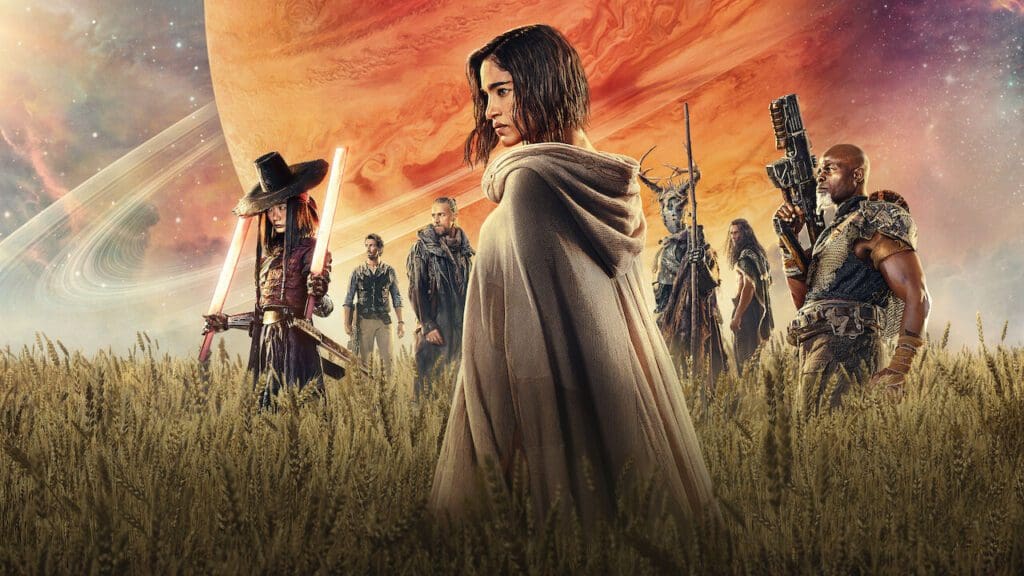Summary
A shallow imitation of Star Wars, Rebel Moon: Part One – A Child of Fire indulges in all of Zack Snyder’s traits as a director, while only constructing the illusion of character and place. Had both been achieved, it would have made the film’s excellent visuals more than just a pretty screensaver.
As a huge Star Wars fan, the prospect of Zack Snyder and Netflix‘s take on George Lucas’ critical work was fascinating. Star Wars itself is a mishmash of Lucas’ take on several genres and directors but produced a world that was still wholly original and filled with interesting themes, amazing characters, and analytical themes. So any work based on it brings expectations of similar quality. Well, watching Rebel Moon: Part One – A Child of Fire should quickly remove that notion.
Lucasfilm’s rejection of Snyder’s idea for a Star Wars film however should have been the first warning that A Child of Fire would be nothing like its source material. Sure, A Child of Fire has an evil Empire, rebels, and takes inspiration from pop culture and the history of the world, but this is all surface-level. Poke at it, attempt to interrogate it further, and Rebel Moon reveals nothing of substance. But worse than this is that it applies Snyder’s trademark grime and self-seriousness that misses the point entirely.
Rebel Moon: Part One – A Child of Fire review and plot summary
Rebel Moon: Part One – A Child of Fire is an introduction to a whole new galaxy, where audiences find themselves on the farming planet Veldt, where the community works and lives harmoniously. One day, the evil Imperium shows up, demanding that the village sell its surplus grain for a seemingly fair price. This offer is refused by the village leader (Corey Stoll with a terrible beard), as before, Kora (Sofia Boutella), a relative newcomer, advised him that the Imperium wants everything. Things inevitably turn sour and the village leader gets his head bashed in by Admiral Atticus Noble (Ed Skrein), who says he will be back in ten months for their next harvest, leaving a garrison behind to make sure this is accomplished.
When the garrison attempts to rape one of the village girls, Kora wipes them out with some gratuitous slow motion and goes to assemble some warriors to defend the farm as they rebel. While A Child of Fire does a lot wrong with this premise, Snyder brings his recognizable cinematic flair to make the camerawork look stunning. It’s a shame most people will watch this at home, as it deserves to be watched on the largest screen possible
A Child of Fire has the foundations for an intriguing galaxy, but it never goes beyond this. The film visits many places in which to recruit its many characters, but they’re no more than short vignettes that hint at how interesting a planet could be if more time was spent developing it. There are worlds with glorious cliffs, polluted mines, and even a world with a gladiatorial colosseum, but none of them feel like places, just planetary backdrops for the film to stick characters on for Kora to then whisk away on her quest.
With Snyder at the helm, it’s unsurprising his trademark style is present, except it’s dialed to 11. The atmosphere is thick with grime alongside an overbearing sense of self-seriousness, and the oppressive slow motion present in nearly every action beat drags it to a crawl. There’s also the over-sexualization of the characters. At the film’s start Kora is pressured to get with a village boy, and two action sequences happen to prevent rape. It’s an attempt at edginess, but it’s just crude. This hints at the fact that this was an R-rated film since there’s also an obvious lack of blood from action scenes — something has been held back for a Snyder Cut, an expected element to please the man’s fanboy cult.
It’s this dark and grungey tone that strangles out a sense of happiness, a feeling conveyed by Kora herself in one of her exposition dumps. There is an attempt at the theme of found family (something that Star Wars is built upon) but the characters are too wrapped up in their own personal dramas to build upon this idea. Characters are also introduced and then quickly folded into the wider ensemble, preventing any meaningful connections from forming. Hopefully, this is something that can be improved upon in Rebel Moon: Part Two – The Scargiver.
Rebel Moon: Part One – A Child of Fire forgets the politics of Star Wars
One of the more interesting parts of Star Wars, and sci-fi in general, is its ability to take parts of real-world history and current politics and use them to influence their worlds, to comment on society and history. Rebel Moon does this in a superficial sense, with its evil colonist empire inflicting its will on the galaxy. It’s also very much modeled on the Roman Empire, with the Senate, names of Admiral Atticus Noble and Regent Balisarius, and their overall attire. But this goes no deeper.
There is no clever criticism of Western Powers or comment on modern politics that might make the audience think about the situation around them and reflect on their world. Sci-fi doesn’t always have to be this, but the deeper imagery and themes it can inspire are absent, and this is disappointing for a film that wants to follow in the footsteps of Lucas’ work. Snyder certainly watched some Star Wars films — some of A Child of Fire’s locations are ripped right from Lucas’ galaxy — but overlooks their political purpose entirely.
What did you think of Rebel Moon: Part One — A Child of Fire? Comment below.
RELATED: Rebel Moon: Part One — A Child of Fire Ending Explained



